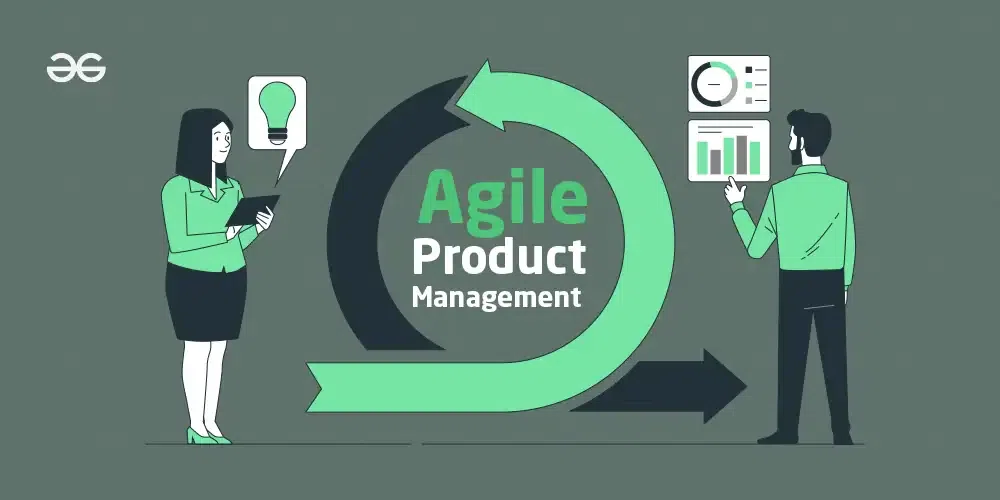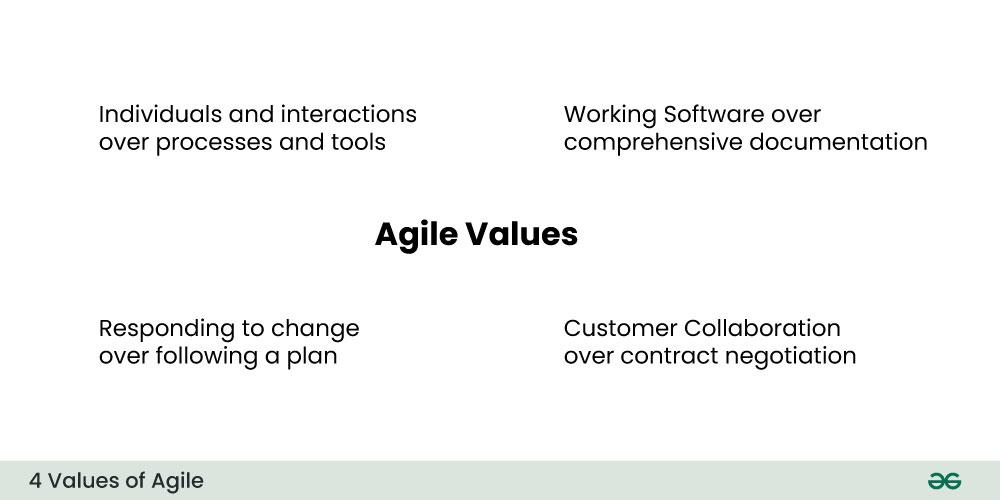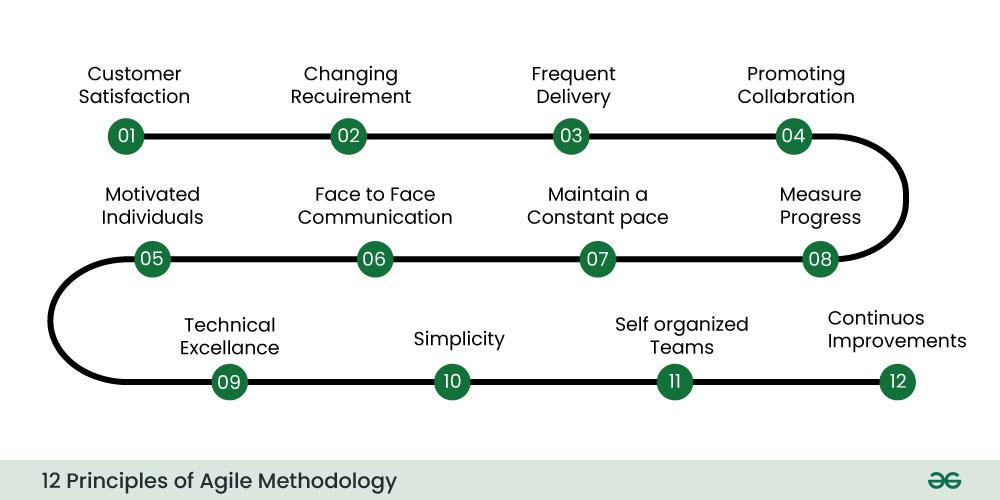In Product Management, things are always changing, and companies need to keep up. The old ways of product management aren’t good enough anymore. That’s where Agile Product Management comes in. It’s a flexible way of doing things that has become popular because it helps teams work together better and keeps the customer in mind. In this article, we’ll break down what Agile Product Management is all about—looking at its basic ideas, how it’s done, and how it can make a product better.

Agile Product Management
What is Agile Product Management?
In simple terms, Agile Product Management is a concept and approach that focuses on speed while taking the demands of customers into account throughout the product development life cycle. As compared to traditional Waterfall approaches, which follow a ‘linear and sequential’ process, Agile uses iterative cycles of operation; developers can return to customers for feedback or modifications constantly. That is a mindset that prioritizes people and interactions over processes and systems, working products over detailed documentation, and customer collaboration over contract negotiation.
- Making items quickly means always changing and focusing on keeping customers happy to release new things. This idea comes from the Agile method, which started in software making but is now used by many other fields too.
- The key thoughts of Agile Product Management are teamwork, being flexible and hearing the opinions from customers. The goal is to quickly give customers what they want and make changes if needed while making the product.
Here are some key aspects of Agile Product Management:
- Iterative Development: Agile Product Management is all about creating products bit by bit and making improvements in time. Rather than making a whole product over a long time, teams work in fast parts called sprints. They usually run for two to four weeks. After each sprint, a product increase that can be delivered is sent.
- Customer-Centric: Agile Product Management is about making customers happy by including users and buyers in the creating process. This means getting ongoing feedback from customers. This helps to make quick changes and improve fast based on how people really use the things they need every day.
- Cross-Functional Teams: Agile teams often have different abilities like development, design, testing and product control. They are made up of folks from different jobs who team up to reach their aim. This aids in working together and making fast decisions
- Product Backlog: The list of important features, updates and fixes is called the product backlog. It’s organized by their importance for what we plan to do with our product in future. The group can change and is tweaked when targets or customer thoughts move.
What are the Four values of Agile Management:
The four values of Agile are found in the paper called “Agile Manifesto”, which is a basic guide for how to use Agile ways. These principles encourages people and teamwork, helpful answers, working with customers together. They also focus on being able to change when needed. Even though the Agile Manifesto doesn’t talk directly about product management, its ideas have been changed and used in different ways with Agile Product Management.

4 values of Agile Product Management
Here are the four core values of the Agile Manifesto
1. Individuals and Interactions over Processes and Tools:
- Highlights how important people are and their talks in making things better.
- Shows the importance of good talking, working together and team play inside a group making things happen. This is also for people involved with what’s being made.
2. Working Solutions over Comprehensive Documentation:
- Focuses on getting a functioning product out quickly rather than writing lots of paperwork.
- Understands the value of a real, useful solution and pushes for results on what works instead of endless record keeping.
3. Customer Collaboration over Contract Negotiation:
- Shows how important it is to include customers and users when making something new.
- Helps work together and talk with customers to better know what they need, collect thoughts on how things are going, and make sure the stuff given is just right as per their expectations.
4. Responding to Change over Following a Plan:
- Recognizes that needs and goals may shift, so the creation process should be flexible.
- Appreciates the skill to quickly react to changing situations, adding new ideas and making plans when needed.
These values started in the area of making software. But now, they are used by many other fields too like managing products. In the way Agile Product Managers do their work, these values help them make products that put customers first. They also promote sharing ideas and being ready to change if needed. Agile Product Management systems, like Scrum, Kanban or Lean give certain ways of working that go with these values. They help to get customers what they want quickly and not waste time.
12 Principals of Agile Product Management
The Agile Manifesto is based on four values and twelve principles that form the basis, for methodologies.

12 Principals of Agile Product Management
Evolution of Agile Product Management
1. Traditional Waterfall Model:
- Sequential, linear approach to development.
- Focus on careful planning and writing down everything.
- Little ability to change when the project starts.
2. Agile Manifesto (2001):
- People matter, solutions that work , working with customers and changing to meet them.
- Start of Agile methods that support step by step growth, adaptability and attention to customers.
3. Agile Practices and Frameworks:
- Using Agile methods like Scrum, Kanban and Lean.
- Continuous loops, mixed squads and ongoing betterment become important.
4. Expansion Beyond Software:
- Applying agile ideas to different types of jobs outside software making.
- The idea of being agile is used in planning projects, making products and how businesses work.
Benefits of Agile Product Management
1. Customer Satisfaction:
- Getting customers to use the product often makes sure it matches what they need and want.
- Adjusting fast to different customer wants makes everyone happier.
2. Faster Time-to-Market:
- Fast development stages and shorter building times result in quicker product releases.
- Allows companies to quickly meet customer needs.
3. Flexibility and Adaptability:
- Agile makes it easy to change needs and goals, encouraging flexibility.
- A Groups can handle feedback and market changes quickly.
4. Improved Collaboration:
- Teams that work together from different areas help people talk and work well with each other.
- Regular meetings like sprint planning and retrospectives help to promote honesty and clear communication.
5. Reduced Risks:
- Checking and confirming product changes often helps to reduce the chance of delivering something that does not please customers.
- Spotting problems early and fixing them helps to reduce dangers.
6. Continuous Improvement
- Teams are encouraged to think about their ways of working and find areas that can get better by doing regular check-ins.
- A culture that always wants to get better results in higher efficiency and quality.
7. Enhanced Team Morale:
- Teams with power and responsibility.
- Reaching small goals step by step helps to feel good and get more motivated.
Agile Product Management roles and responsibilities
In Agile Product Management, there are big jobs and people you need to help make sure a product develops well. While specific responsibilities can vary based on the organization and the chosen Agile framework, the following are common responsibilities and roles associated with Agile Product Management:
1. Product Vision: Tell what the big picture and aims are for making or selling a product.
2. Product Backlog Management: Make sure the list of things to add or fix, which changes often in a product is kept important and updated.
3. Requirement Definition:
- Work with others to set and explain what a product needs.
- Turn big features into small jobs that development teams can work on during short bursts of time called sprints.
4. Decision-Making: Make choices about which features to put first and any swaps based on what the business is worth and needs of customers.
5. Stakeholder Communication: Help connect the group making a thing and those who want to use it, so everyone knows what they’re trying to do with the product.
6. Acceptance Criteria: Make clear rules about what needs to be done for user stories. This will help the team build features that are up to standard and satisfy all requirements.
7. Release Planning: Work with people who matter to plan when new products will come out. Think about what the business wants and needs from those it sells to.
Scrum Master (if using Scrum):
- 1. Scrum Process Facilitation:
- Help with Scrum events (planning meetings, daily check-ins, reviewing sprints and looking back).
- Make sure you follow the rules and methods of Scrum.
- 2. Seam Support: Help the group making things by getting rid of any problems and creating a team-friendly place to work well.
- 3. Continuous Improvement: Help the team and Agile processes to always get better.
Development Team:
- Task Execution: Create and give product features during short bursts, using user stories with high importance tasks.
- Collaboration: Work with the Product Owner to learn what is needed and provide excellent solutions focused on satisfying customers.
- Self-Organization: Organize yourself to decide the best way to reach sprint goals and give value to customers.
Stakeholders:
- Feedback: Give regular comments on product changes. Work with the Product Owner to improve and change priorities according to what the business needs.
- Participation in Sprint Reviews: Go to sprint reviews to see the small parts of product that have been made and give your thoughts on what should be developed next.
Agile Coach (optional):
- Guidance: Explain the main ideas and methods of Agile. Help groups and people use Agile ways of working well.
- Training: Run classes to teach the team about Agile ideas and ways of working.
UX/UI Designer (if applicable):
- User-Centric Design: Work with the Product Owner and development team to make sure that user-friendly design rules are followed.
- Prototyping: Make sample things and build parts to help in making user stories.
These jobs and duties go with the Scrum method, one of the most used Agile ways to do things. In some groups, job positions might be mixed or changed to match the unique requirements and setting of making a new product. The main thing is to keep working together with customers and make sure we can change often while always trying to get better.
There are many tools made to help with Agile Product Management processes. These tools helps groups in handling their tasks, working together well and following along with progress. Here are some popular Agile product management tools:

Agile Product Management Tools
- Jira: Jira is a very popular tool used by many people for managing projects with Agile methods. It helps manage past tasks, plan for sprints and track problems.
- Trello: Trello is a tool that helps people work together. It uses boards, lists and cards to organize tasks and keep track of how things are going. It’s easy to use and good for little groups.
- Asana: Asana is a helpful tool that can help manage projects, keep track of tasks and work with teams. It has functions that work well with Agile ways of working.
- VersionOne: VersionOne is a tool for managing Agile projects. It helps manage the backlog, plan sprints and make reports.
- Targetprocess: Targetprocess is a tool for visual management that helps with Agile ways like Scrum and Kanban. It has tools for dealing with tasks waiting to be done, making plans for short time periods called sprints and giving reports.
- Monday.com: Monday.com is a system that helps manage work and collaboration for projects. It offers tools for organizing and monitoring work in an Agile environment.
These tools usually connect with version control systems, continuous integration tools and other software making tools to give a full answer for Agile teams. The team decides which tool to use based on what they like, how they work and special needs.
Best Practices for Agile Product Management
Working as a product manager in an agile product management needs flexibility. Due to this product managers must constantly change the product roadmap and reprioritize what to produce in response to consumer feedback. Here are some simple and effective practices:
Set a Clear Plan
In Agile Product Management, set a clear strategy for your product. Think about where you want it to go in the long run. Talk to customers, understand their problems, and set goals that match the company’s overall plans.
Listen to Customers
Keep a close ear to what customers need. Agile is about giving them value fast. Get feedback early and often so you can be sure your product is doing what users want.
Plan in Short Terms
Create a roadmap for your product in the short term. This plan, usually covering a few months, can change as needed. It should follow the overall strategy and bring real value to customers.
Adapt Regularly
Be ready to change things. Agile is about adjusting plans when necessary. If something isn’t working or there’s a better way, be open to adapting your roadmap.
Frameworks Used in Agile Product Management
Scrum Framework
Scrum is a systematic way of developing products. It is one of the most widely used Agile frameworks around. It has fixed-length iterations (sprints), daily stand up meetings, regular reviews and retrospectives. With scrum, teams deliver a potentially shippable product increment at the end of each sprint.
Kanban Method
A second Agile framework is Kanban, where the work flow charted out on a screen. Because work items transit through different stages, teams are able to control the amount of WIP. Kanban stresses a pull system. The system pulls in work according to capacity and demand.
Scaled Agile Framework, or SAFe, is a framework for scaling agile principles and methods across large organizations. It was created to address the challenges that organizations face when attempting to adopt Agile at scale. SAFe provides a structured approach to implementing Agile practices while preserving the flexibility and adaptability that are at the core of Agile methodologies.
Lean Startup Principles
Many of the ideas in Agile Product Management are borrowed from Lean Startup. This means rapid development of a minimum viable product ( MVP) that gets released to the market as soon as it’s possible, gauging results from users and optimizing accordingly. The lean approach eliminates waste and shortens time to market.
Global Collaboration and Remote Work with Agile Product Managements
Agile approaches have received more attention since the arrival of remote work. Agile approaches that encourage communication and cooperation are ideal for teams spread across multiple geographic locations. That the principles of Agile Product Management can still be effective in a decentralized, globalized environment is largely thanks to tools such as video conferencing, collaborative documentation and virtual boards that make it possible for agile teams 20 miles apart yet not too far away.
Scaling Agile for Larger Projects
While Agile methodologies like Scrum and Kanban are suitable for small teams and projects, as the team grows larger or its task becomes more complex, scaling it becomes an important consideration. Safe, Less and Nexus are just a few examples of frameworks designed to coordinate the activity of multiple Agile teams. Scaling Agile means that organizations can retain the benefits of agility and ensure a single integrated plan for the whole enterprise.
Continuous Integration and Continuous Delivery (CI/CD)
Agile Product Management naturally fits in with continuous integration and deployment (CI/CD) practices to create a culture that prizes automation. Teams can deliver software more reliably and efficiently by automating testing, integration and deployment processes via CI/CD pipelines. This conforms to Agile emphasis on delivering working software repeatedly and shortens the time from ideas to valuable functions.
Embracing DevOps
The DevOps method, an extension of Agile concepts, stresses cooperation and interaction between development and operations personnel. Especially in terms of stages following the deployment, traditional boundaries between development and operations are collapsed by DevOps. Mantra £ Combined with Agile Product Management, then entire product lifecycle from coding to maintenance is smooth flowing operated efficiently.
In Agile Product Management, success is measured by monitoring more than project management metrics. Possible key performance indicators are lead time, cycle time, customer satisfaction scores and the speed with which development teams work. These measures provide a good guide to how productive the team is.
Cultural Transformation
But agile isn’t just a series of processes; it’s cultural transformation. To transform from a traditional, hierarchical structure into an Agile culture requires change in mindset at all levels of the organization. Leaders need to encourage experimentation and accept failure as a means of learning, while teams should be equally encouraged to make decisions on their own. Fundamental to the long-term success of Agile Product Management is this cultural shift.
Challenges and Considerations
Although Agile Product Management offers many advantages, it is essential to recognize potential problems. Such factors may include resistance to change, problems switching from older methods and heavy organizational investment in the Agile principles.
Conclusion: Agile Product Management
Agile Product Management is distinct from traditional project management methods. It allows teams to be flexible and take charge, which is ideal for modern fast-changing corporate landscape. Agile methodologies enable teams to work quickly and efficiently while developing software, generating products, or solving any type of business problem. Companies that understand and employ these approaches will remain competitive in a world that is constantly shifting.
Share your thoughts in the comments
Please Login to comment...